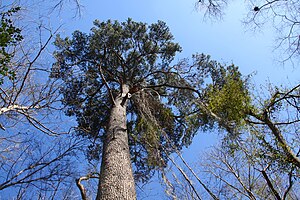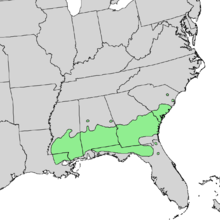Pinus glabra
| Pinus glabra | ||||||||||||
|---|---|---|---|---|---|---|---|---|---|---|---|---|

Pinus glabra |
||||||||||||
| Systematics | ||||||||||||
|
||||||||||||
| Scientific name | ||||||||||||
| Pinus glabra | ||||||||||||
| Walter |
Pinus glabra is an evergreen conifer from the genus of the pines ( Pinus ) with usually 4 to 8 centimeters long needles arranged in pairs and 4 to 7 centimeters long seed cones. The natural range is in the southeastern United States. The species is not endangered. It is of little economic importance and is hardly used for horticulture.
description
Appearance
Pinus glabra grows as an evergreen tree , 30 to 35 meters high. The trunk is straight and columnar and reaches a chest height diameter of up to 100 centimeters. The largest known specimen was measured in 2003 with a height of 47.6 meters, a crown diameter of 21.4 meters and a trunk diameter of 1.2 meters. The trunk bark is thick, gray-brown and gray when exposed to the weather. It remains smooth and scaly for a long time, later breaking up into small, irregular, elongated plates, which are separated by shallow furrows. The bark of the branches is gray, smooth and does not peel off. The few main branches are horizontal or upright and form a rounded or flat crown in older trees. The needled branches are thin, reddish to purple-brown, hairless and rough after the needles have been lost due to permanent pulvini . Young shoots are initially bluish and later gray.
Buds and needles
The buds are egg-shaped, 5 to 10 millimeters long, pointed and slightly resinous. The lower leaves, which are designed as bud scales, are reddish brown and have narrow edges. The needles grow in pairs in a needle sheath that is initially 5 to 10 millimeters long and later shortens to 3 to 7 millimeters. They are dark green, stiff, straight, slightly twisted around the longitudinal axis, 4 to 8 centimeters long and 0.7 to 1.2 millimeters wide and stay on the tree for two to three years. The edge of the needle is finely sawn, the end pointed. There are narrow stomata lines on all needle sides . Two or three resin channels are formed.
Cones and seeds
The pollen cones grow in small groups in a spiral. They are short, cylindrical, 1 to 1.5 inches long, initially slightly purple and later brown. The seed cones grow individually or in pairs. They are stalked up to 1 centimeter long, 4 to 7, rarely from 3 or 10 centimeters long, closed ovoid-elongated and open ovoid-cylindrical, initially green and red-brown when ripe. They ripen after two years, open wide to release the seeds and then stay on the tree for three to four years before they fall off together with the stem. The 60 to 90 seed scales are broadly wedge-shaped, thinly woody and more or less flexible at the base. The apophysis is slightly raised, transversely keeled, irregularly rhombic in outline or has a rounded upper edge. The umbo is lowered or blunt, unreinforced or reinforced with a weak, sloping small spine . The seeds are obovate to almost deltoid, 5 to 6 millimeters long and spotted brown. The seed wing is 12 to 15 millimeters long.
Chromosome number
The number of chromosomes is 2n = 24.
Distribution, ecology and endangerment
The natural range of Pinus glabra is in the southeastern United States in Alabama, in northern Florida , in Georgia , in eastern Louisiana , in Mississippi and South Carolina .
The species grows in the warm temperate climate of the lowlands in the southeastern United States at heights of up to 150 meters. The summers in the natural range are long, hot and humid, the winters mild. The distribution area is assigned to winter hardiness zone 8 with mean annual minimum temperatures of −12.2 ° and −6.7 ° Celsius (10 to 20 ° Fahrenheit ). The trees are scattered in river valleys, on river banks, on hills and in wetlands on acidic ground. Young trees usually grow in the shade of deciduous trees such as representatives of the magnolias ( Magnolia ), the tulip tree ( Liriodendron tulipifera ), the American sweetgum tree ( Liquidambar styraciflua ), representatives of the tupelo trees ( Nyssa ), the hickory ( Carya ), the beech ( Fagus ) and of the oaks ( Quercus ), which they surpass in height over time. This shade tolerance is rather unusual in pines and decreases with the height of growth, so openings in the canopy are often necessary so that the species can outperform the other trees. Unlike other pine trees, Pinus glabra is susceptible to fire. In addition to the deciduous trees, it is also found together with Pinus elliottii , the frankincense pine ( Pinus taeda ) and the bald cypress ( Taxodium distichum ).
In the Red List of the IUCN is Pinus glabra classified as endangered ( "Lower Risk / least concern"). However, it should be noted that a reassessment is necessary.
Systematics and research history
Pinus glabra is a species from the genus of the pines ( Pinus ), in which it is assigned to the subgenus Pinus , Section Trifoliae and Subsection Australes . It was first scientifically described in 1788 by Thomas Walter in the Flora Caroliniana . The generic name Pinus was already used by the Romans for several types of pine. The specific epithet glabra means bald and refers to the hairless young shoots. The species has no synonyms .
Pinus glabra is similar in tree shape to the Weymouth pine ( Pinus strobus ), shoots and needles are similar to those of Pinus echinata , but the needles are darker and the cone scales less prickly. It can form hybrids with Pinus echinata , but no natural hybrids are known.
use
The wood from Pinus glabra is of poor quality, it is brittle and not very durable. Together with the scattered appearance, this prevents intensive use. Locally, if it grows together with other pines, it can have a certain economic importance as a timber supplier. It is used as a Christmas tree in some areas, but needs frequent pruning to achieve the desired shape and density of branches. It is rarely used horticultural outside of botanical gardens and arboretums .
swell
literature
- Aljos Farjon: A Handbook of the World's Conifers . tape 2 . Brill, Leiden-Boston 2010, ISBN 90-04-17718-3 , pp. 678-679 .
- James E. Eckenwalder: Conifers of the World. The Complete Reference . Timber Press, Portland, OR / London 2009, ISBN 978-0-88192-974-4 , pp. 433 .
- Flora of North America Editorial Committee (Ed.): Flora of North America North of Mexico . Volume 2: Pteridophytes and Gymnosperms . Oxford University Press, New York / Oxford a. a. 1993, ISBN 0-19-508242-7 (English).
- Helmut Genaust: Etymological dictionary of botanical plant names. 3rd, completely revised and expanded edition. Nikol, Hamburg 2005, ISBN 3-937872-16-7 , p. 487 (reprint from 1996).
Individual evidence
- ↑ a b c Aljos Farjon: A Handbook of the World's Conifers , Volume 2, p. 678
- ↑ a b c d e f James E. Eckenwalder: Conifers of the World , p. 433
- ^ A b c Robert Kral: Pinus glabra in Flora of North America , Volume 2
- ^ Aljos Farjon: A Handbook of the World's Conifers , Volume 2, pp. 678-679
- ↑ a b c Aljos Farjon: A Handbook of the World's Conifers , Volume 2, p. 679
- ↑ a b Pinus glabra in the Germplasm Resources Information Network (GRIN), USDA , ARS , National Genetic Resources Program. National Germplasm Resources Laboratory, Beltsville, Maryland. Retrieved May 10, 2013.
- ↑ Pinus glabra in the endangered Red List species the IUCN 2012. Posted by: Conifer Specialist Group, 1998. Accessed on May 10, 2013.
- ↑ Exactly: Etymological dictionary of botanical plant names p. 487
- ↑ Pinus glabra. In: The Plant List. Retrieved May 10, 2013 .
Web links
- Pinus glabra at Tropicos.org. Missouri Botanical Garden, St. Louis, accessed May 10, 2013.
- Christopher J. Earle: Pinus glabra. In: The Gymnosperm Database. www.conifers.org, November 27, 2012, accessed on May 11, 2013 .
- Teo Spengler: What Is A Cedar Pine: Tips On Planting Cedar Pine Hedges. www.gardeningknowhow.com, accessed March 1, 2016 (English).


